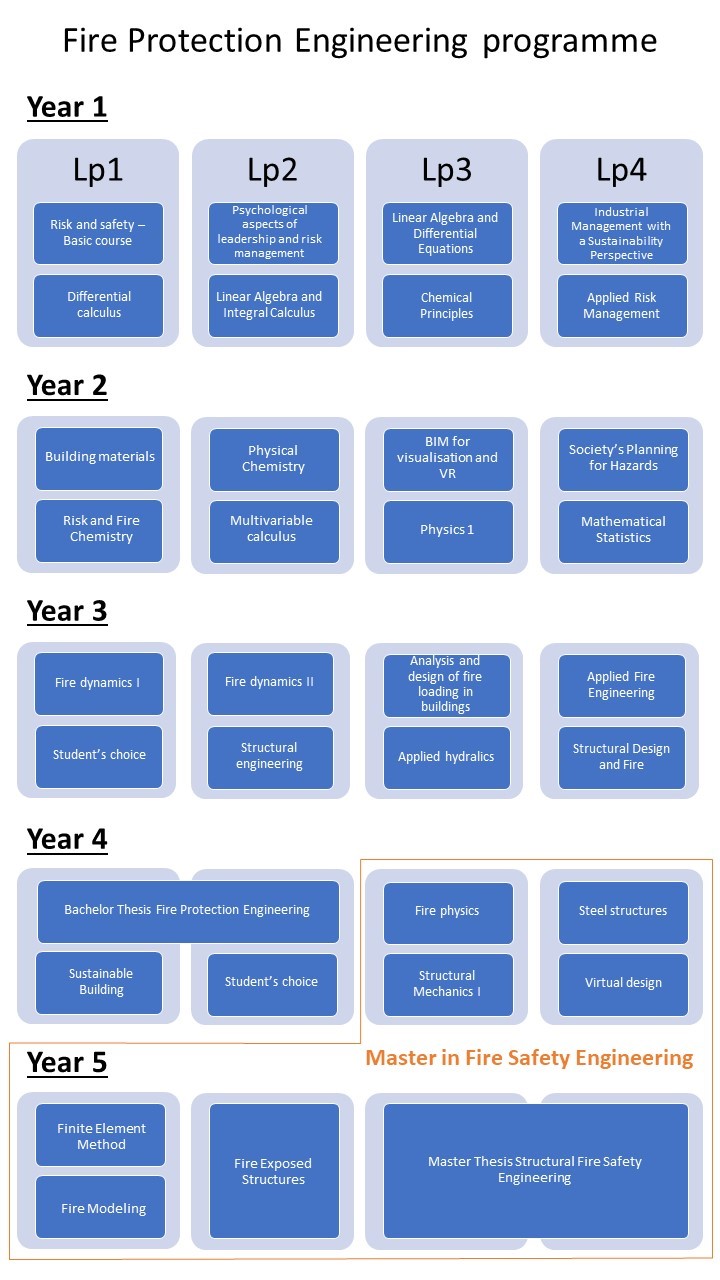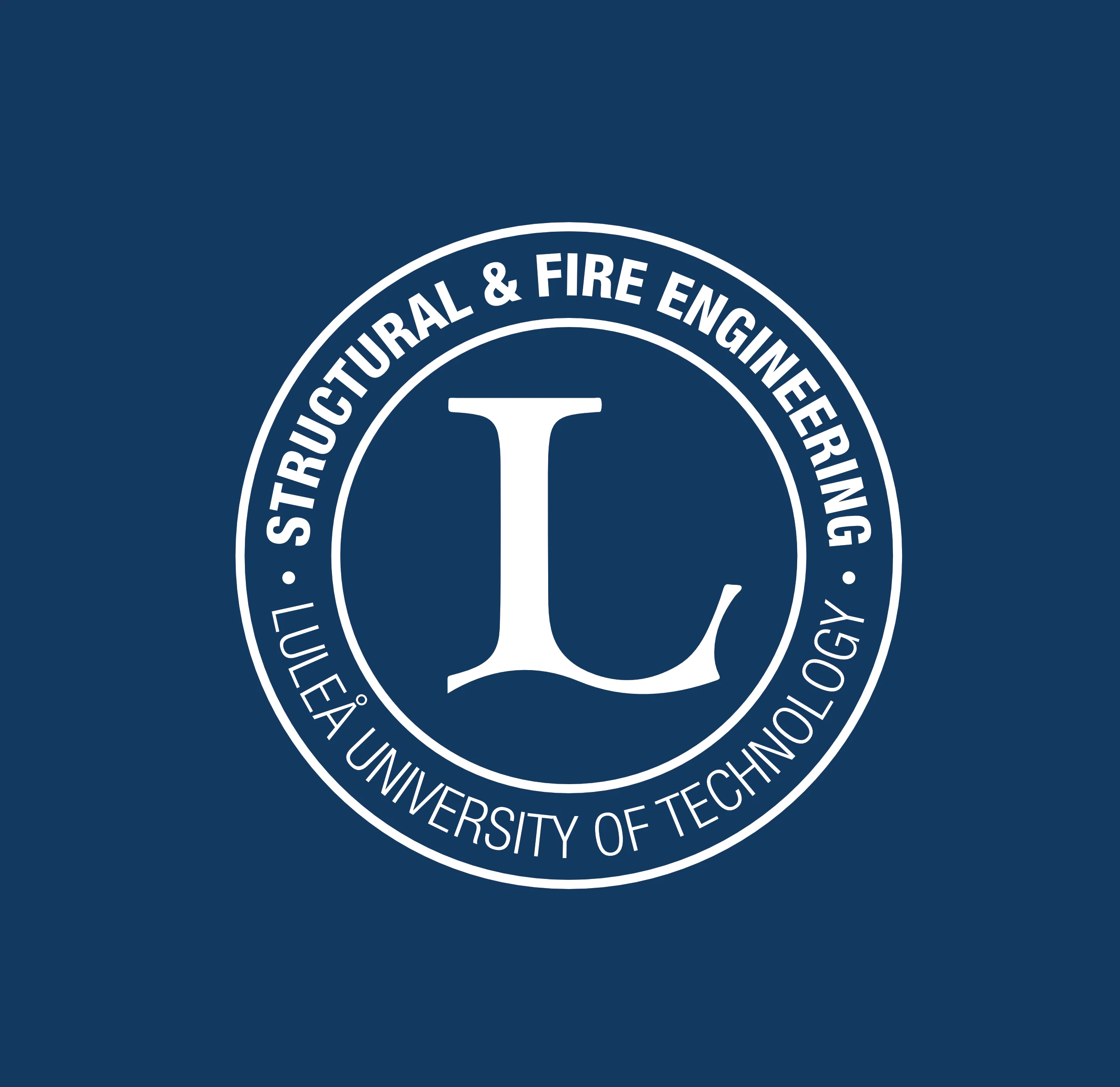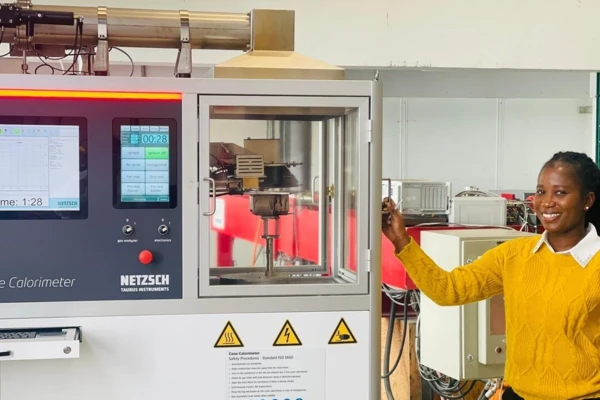
Customer SUCCESS STORY
Fire Resistance Testing and Fire Safety Engineering
The NETZSCH TAURUS Cone Calorimeter TCC 918 in Use at Luleå University of Technology, Sweden
This is a customer success story byRhoda Afriyie Mensah, Postdoctoral researcher at the Structural and Fire Engineering division, Department of Civil, Environmental and Natural Resources Engineering, at Luleå University of Technology (LTU) in Sweden. She talks about the use of the TCC 918 Cone Calorimeter and its unique programming variations in heat flux throughout the test duration, which were crucial for the fire resistance testing projects at LTU and which have led to the development of innovative approaches in the field of fire safety engineering.

„I would describe your solutions and services as effective. The cone calorimeter is particularly impressive with its ability to simulate various fire scenarios and user-friendliness. Additionally, the prompt customer support from your team adds considerable value to your product.“
About the Luleå University of Technology
Luleå University of Technology (LTU) is situated in northern Sweden, Luleå, Norrbotten county. LTU is renowned for its cutting-edge research and innovative education programs. Currently, it has an annual turnover of SEK 2.0 billion, 1,500 employees, and 17,900 students. With a focus on sustainability, engineering, and technology, it fosters a dynamic learning environment that encourages collaboration and critical thinking. The university has modern facilities and strong ties to industry ensuring students receive hands-on experience and practical skills essential for success.

One of the niche educational programs at LTU is the Fire Protection Engineering (FPE) program overseen by Prof. Michael Försth. The FPE program at LTU offers a Bachelor's and a Master of Science degree. This program is within the Department of Civil, Environmental, and Natural Resources Engineering and the Division of Structural and Fire Engineering. It focuses on the application of science and engineering principles to protect people, property, and their environments from fire and smoke hazards.


The curriculum includes both theoretical courses and practical laboratory work, utilizing facilities like the Fire Protection Engineering Laboratory. This laboratory is well-equipped with advanced tools such as a cone calorimeter, a microscale combustion calorimeter (MCC), a limiting oxygen index (LOI) tester, and a specialized fire furnace, Fire Protection Engineering Laboratory.
From these instruments, the cone calorimeter and LOI tester were procured from NETZSCH TAURUS Instruments GmbH. These instruments are vital for studying the heat transfer and flammability of materials, providing students with hands-on experience in assessing fire dynamics and the response of different materials to fire.
Rhoda, could you please introduce yourself, your university and fields of application/research?
I am Rhoda Afriyie Mensah, a postdoctoral researcher at Luleå University of Technology (LTU) in Sweden. I pursued a PhD. in Mechanical Engineering at Nanjing University of Science and Technology in China, where I researched the application of Artificial Intelligence in thermal analysis and flammability of materials. I started my post-doctoral studies with the fire protection engineering group under the structural and fire engineering division at LTU in 2021. My research background centers on assessing the fire behavior of materials and incorporating fire retardants in materials to make them less flammable. For my research, I have used various fire testing instruments including the cone calorimeter and the microscale combustion calorimeter. I also teach a heat transfer course to the fire protection engineering students and manage the fire protection engineering laboratory as part of my duties.
Since when has the cooperation with NETZSCH existed and what were the specific challenges your division had before using our solutions?
The cooperation started in August 2022. Before implementing the NETZSCH TCC 918 cone calorimeter, the Fire Protection Engineering Laboratory faced significant challenges with our old cone calorimeter. The device had an open combustion chamber, posing a risk of exposure to flames and heat to users. Additionally, the older model utilized Drierite, a desiccant containing toxic chemicals. We sought a solution that would address these concerns while enhancing our capability to conduct fire behavior studies effectively. The TCC 918 offered a safer, enclosed combustion chamber and eliminated the need for toxic substances, thereby resolving our concerns.

Why did you choose NETZSCH? How did our solutions help solve these challenges?
We chose NETZSCH for their reputation in providing high-quality, reliable thermal analysis equipment tailored for educational and research environments. Their TCC 918 model offered advanced safety features, including an enclosed combustion chamber that mitigated previous risks, and user-friendly software, which is essential for effective learning.
The TCC 918 from NETZSCH effectively addressed our challenges by providing a safer and more advanced calorimeter system. The enclosed combustion chamber significantly reduced the exposure risks to flames and heat, ensuring a safer environment for our staff. The elimination of toxic substances like Drierite in the experimental process further enhanced safety. Moreover, the TCC 918’s user-friendly software improved the ease of conducting experiments and analyzing data, facilitating a more productive and educational experience. This solution not only solved our safety concerns but also elevated the quality and scope of our research capabilities.
Rhoda, would you tell us more about your specific application?
Since its installation at Luleå University of Technology, the NETZSCH TCC 918 cone calorimeter has been extensively utilized to explore the reaction-to-fire properties of a diverse range of materials. For example, we have successfully used this advanced equipment to study the flammability and combustion behaviors of materials like wood, plastics, textiles, composites, biochar, various plants, and even concrete. This has allowed us to gather critical data on how these materials behave in fire scenarios, significantly contributing to our research in fire safety engineering and helping develop safer material applications and fire prevention strategies in the construction and materials industries.
Please go into detail and explain your analysis and measurement results.
The below graph presents heat release rates (kW/m²) of various materials over time (seconds) measured from our NETZSCH TAURUS TCC 918 instrument. Here's a breakdown of the labels:
Neat WG (Neat Wheat Gluten): This line (black) shows the heat release rate of pure wheat gluten compressed molded without any additives. It exhibits a sharp peak early, reaching over 700 kW/m², then quickly decreases, stabilizing near zero, indicating rapid combustion.
BC_APP_WG_COMP (Biochar-Ammmonium Polyphosphate Wheat Gluten Composite): This line (red) represents a composite of wheat gluten, biochar, and ammonium polyphosphate, a fire retardant. It shows a much lower and more gradual heat release rate, peaking around 150 kW/m² and slowly tapering off, which suggests that the addition of biochar and ammonium polyphosphate significantly reduces the flammability and peak heat release rate of the wheat gluten by 74%.
BC_Lanosol_WG_COMP (Biochar-Lanosol Wheat Gluten Composite): The line (blue) indicates a composite of wheat gluten, biochar, and Lanosol, a fire retardant. Similar to the BC_APP_WG_COMP, this composite also shows a reduced peak heat release rate of 14% compared to neat wheat gluten. It peaks higher than the BC_APP_WG_COMP but remains significantly lower than the Neat WG, indicating effective flame retardancy.
The curves also show that the addition of lanosol and biochar slightly improved the time to ignition of neat WG, however, APP and biochar significantly improved the time to ignition.
Overall, the graphs illustrate the effectiveness of different additives (biochar with ammonium polyphosphate and Lanosol) in reducing the heat release rate and the time to ignition of wheat gluten when exposed to fire, which is important for enhancing the fire safety of materials made from wheat gluten.

Were there any special features of the fire testing device that were particularly useful for your specific application?
The TCC 918 cone calorimeter possesses a unique capability vital for our fire resistance testing projects. Unlike traditional reaction-to-fire tests where samples are subjected to a constant heat flux, the TCC 918 allows for programming variations in heat flux throughout the duration of the test. This feature enabled us to accurately implement and simulate various fire curves, including the standard fire curve and the parametric curves. By inputting the equations of these curves into the system, we could adjust the parameters dynamically to mirror the conditions these curves represent.
This advanced functionality was instrumental in exposing concrete samples of various thicknesses to both standard and specialized temperature curves effectively. The team at Luleå University of Technology leveraged this feature to conduct comprehensive fire resistance tests, enhancing our understanding of material behaviors under different fire conditions. This adaptability and precision make the TCC 918 an invaluable tool in our ongoing research in the field of fire safety.

How did you use the results obtained to improve your research, quality control, development or production?
The cone calorimeter was instrumental in allowing us to subject materials to the standard ISO 834 curve and the parametric curves, in small scale, crucial for evaluating the fire resistance of construction materials. Its control system was adept at adhering to this curve up to its maximum temperature limit of 1000°C, covering the requirements for most material tests. This feature was especially valuable in supporting one of our project's objective to scale down the size of tests for screening purposes. The versatility of the cone calorimeter enhanced our testing processes, helping us make screening fire resistance testing more accessible and cost-effective. This capability is aligned with our long-term project goal of broadening the availability of fire resistance testing, which is particularly advantageous for assessing new materials and technologies in the construction industry.
How did the use of our solutions or the analysis results impact your business? Did you achieve significant savings or efficiencies?
Yes, we will achieve significant savings and efficiencies by using the cone calorimeter compared to traditional fire resistance tests. Traditionally, these tests require very large samples, but with the cone calorimeter, we only needed samples measuring 100 by 100 mm with a thickness of up to 50 mm. This reduction in sample size significantly decreases the amount of material used and, as a result, the overall testing costs. Additionally, the energy consumption of the cone calorimeter is much lower than that of a large furnace typically used in fire resistance testing. This not only translates to direct energy savings but also contributes to a more sustainable testing process by minimizing environmental impact. These efficiencies will make fire resistance testing more accessible and cost-effective, aligning with our goals to improve testing availability and reduce operational costs. However, it must be emphasized that these are small-scale tests for orientational and screening purposes. For the classification of construction elements, large-scale furnace tests are required.
Did our solutions also help improve the quality of your products or optimize your workflows?
Yes, using the cone calorimeter significantly improved the quality of our fire testing processes, which, in turn, enhanced the quality of the materials and products we evaluated. The precision and adaptability of the cone calorimeter allowed us to conduct more accurate and detailed analyses of materials under various fire conditions. This enhanced testing capability enabled us to optimize material compositions and treatments for better fire resistance, leading to the development of safer and more reliable materials.
The TCC 918 significantly optimized our workflows, reduced the workload of our employees, particularly in the context of educational, and research settings at the university. Its efficiency and ease of use allowed for quicker setup and execution of experiments, which is ideal for student labs where time and user friendliness are important. Students could conduct multiple tests in a shorter period, enhancing their learning experience by allowing more hands-on time with the equipment and immediate results for analysis. For research projects, the smart nature of the cone calorimeter ensures that researchers can run more tests with less preparation time, leading to more efficient research cycles and quicker progression from hypothesis to conclusion. The introduction of the new cone calorimeter in our lab has improved productivity by enabling more effective time management and reducing the manual effort required in setting up and conducting fire tests.
Have you been able to gain new research insights or has a completely new development resulted?
Yes, the use of the cone calorimeter has enabled us to gain new research insights and has even led to the development of innovative approaches in the field of fire safety engineering. The device's precision and flexibility in simulating various fire scenarios allowed us to deeply investigate the fire behavior of different materials, including those not typically included in standard fire tests like biochar. This has opened up new avenues for understanding how materials combust and interact under fire conditions. One significant advancement is the development of fire-retardant material formulations. By observing how different composites behave in controlled fire tests, our researchers have been able to tweak material compositions to enhance their resistance to heat. These insights have also contributed to the broader field of fire safety. Additionally, the calorimeter has facilitated interdisciplinary collaborations, combining insights from chemistry, wood science, and fire safety engineering divisions from other institutions to explore the flammability of materials. This collaborative approach has not only broadened the scope of our research but also increased its impact.

Have you also made any experience with our customer support and service?
Our experience with your customer support and service has been exceptionally positive, particularly due to the contributions of the expert team of NETZSCH TAURUS Instruments. Their prompt and knowledgeable responses have been instrumental in ensuring that our use of the cone calorimeter is both effective and efficient. Whenever we encountered technical challenges during commissioning or had questions about the equipment, the team of NETZSCH Taurus provided swift and accurate support, significantly minimizing any downtime and enhancing our overall productivity. Their expertise not only helped in routine maintenance and troubleshooting but also in optimizing the use of the calorimeter for our specific research needs. We greatly appreciate their dedication and professionalism, which have markedly improved our experience and satisfaction with your services.
Are there any other challenges you would like to address to us for the future?
Looking ahead, we are excited to deepen our collaboration with your team, focusing on advanced material fire testing and the development of eco-friendly and fire-resistant materials that could redefine industry standards. We also anticipate the need for advanced technology in the equipment such as the addition of a camera to obtain real-time in-situ measurements. Additionally, we see great value in expanding training programs and workshops to ensure that our team can fully leverage the evolving capabilities of your equipment. This continued partnership will not only enhance our research capabilities but also contribute to significant advancements in fire safety technologies.
Thank You!
Rhoda, thank you very much for this interview, the exciting insight into your work and the positive words! We look forward to accompanying you in the future with the help of our analysis devices on the further path to advanced material fire testing and the development of environmentally friendly and fire-resistant materials.
